10,000 Years of Strangeness: A Paranormal Primer for Ancient and Modern China
Part III: Mysteries and Legends
Chapter 13: The Kanas Lake Monster--喀纳斯湖水怪
Chapter 13: The Kanas Lake Monster--喀纳斯湖水怪
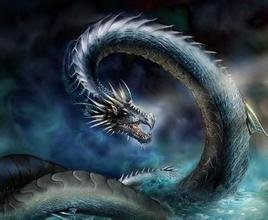
Previous Chapters 前章: Part 1: Chapter 1, Ch 2, Ch 3, Ch 4, Ch 5-1, Ch 5-2, Ch 5-3, Ch. 6
Previous Chapters 前章: Part 2: Chapter 7, Ch 8-1, Ch 8-2, Ch 8-3, Ch 8-4, Ch 8-5, Ch 9, Ch 9a
Previous Chapters 前章: Part 3: Chapter 10, Chapter 11-1, Chapter 11-2, Chapter 12
Previous Chapters 前章: Part 3: Chapter 10, Chapter 11-1, Chapter 11-2, Chapter 12
China’s not famous for its Lake Monsters like Scotland, Canada and the US. These three countries abound with aquatic legends that have become internationally famous. The creature with the most notoriety is, of course, the Loch Ness Monster in Scotland. But not to be outdone, Lake Champlain on the New York-Vermont border is said to be the home of “Champy” with written records going back to 1609. British Columbia is home to Ogopogo of Okanagan Lake. Canada and the US may even share a few lake monsters that live in Lake Erie and Lake Superior.
But the lake monsters that live outside the English-speaking world haven’t yet achieved the notoriety those creatures have that live within. Nonetheless, they have achieved national fame in their home countries, and one of them is in China—The Kanas Lake monster or kanasi hu shuiguai in Chinese (喀纳斯湖水怪). Kanasi hu means “Kanas Lake” and shuiguai means literally “water monster.” And its history supposedly goes back to at least the 13th Century.
Kanas Lake is located in northwestern China in the remote northernmost tip of Xinjiang Province, and is accessed only with difficult local ground transportation. It’s a glacial lake in the Altai Mountains that geologists tell us formed about 200,000 years ago (though one expert we’ll meet shortly makes it much younger). It’s about 15 ½ miles long by a mile and half wide. At over 600 feet, it is the deepest glacial lake in China.
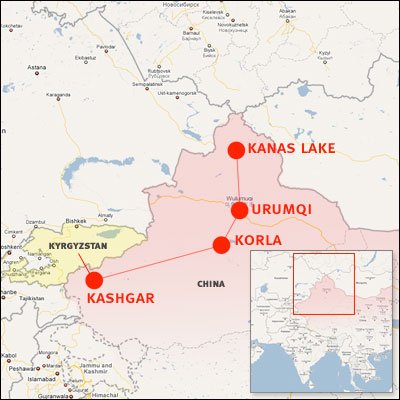
Even without the monster the lake would still be awe-inspiring. It is surrounded by snow peaks, dense arboreal forests, and grasslands. The waters of the lake change color constantly due to the settling particulates washed into it from glacier-fed streams. The local Tuvan and Kazakhs make up the local ethnic enclaves and live in villages around the lake. Mountain glories or Brocken Spectres occur regularly and are called Buddha’s halo by locals. In addition to this known phenomenon, locals say that strange lights are often seen in the sky at night. Glories can only occur when the sun it out. Later, we’ll take a deeper look at this nighttime phenomenon associated with the lake.
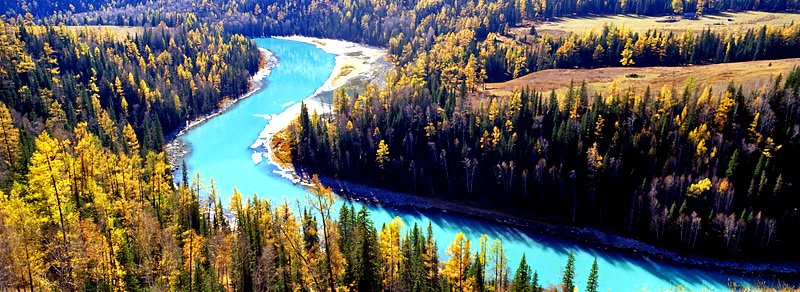
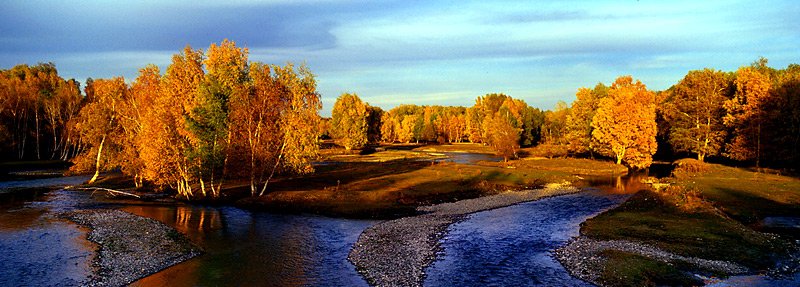
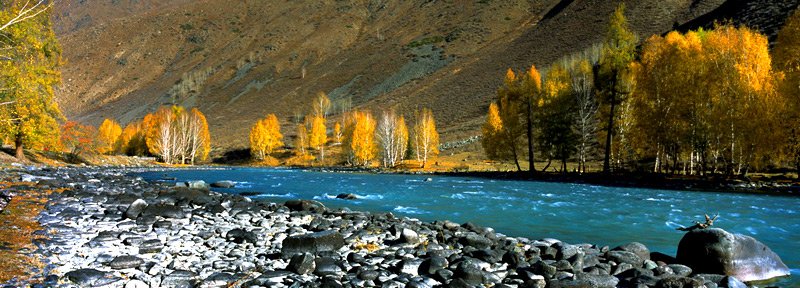
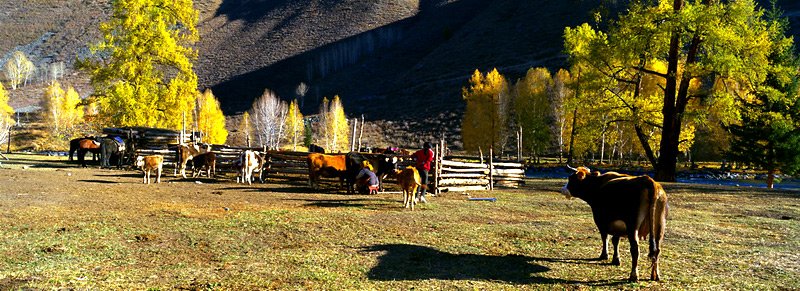

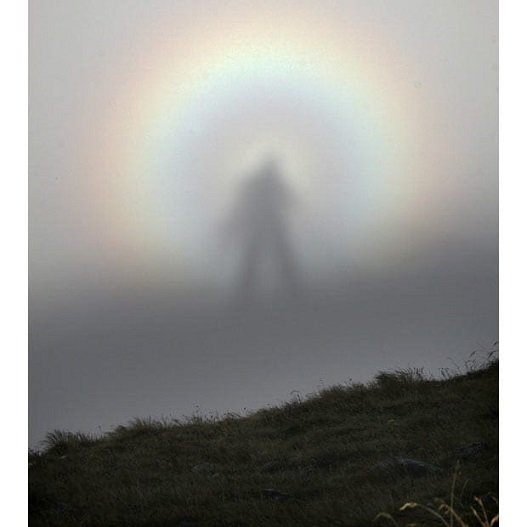
Poo-pooers of the Kanas Lake monster allege that the story was invented recently to lure tourists to the remote lake. While the legend may have been aggrandized recently for this purpose, the monster has been known to the Tuvans for centuries. Their ancient tales tell of a monster that lived in the lake that snatched sheep, cattle and even horses that wandered to close to the water’s edge. The Tuvans aver that this continues to happen to this very day.
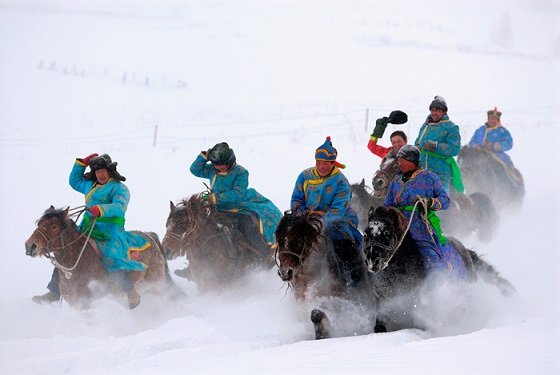
In recent years the number of reliable sightings has increased as China’s population grows in affluence and the number of tourists with video recorders and cameras increases. This has made the Kanas Lake monster perhaps the best documented mysterious creature in the world, and yet outside China it remains largely unknown. In fact, sightings appear to be so regular that by now they surely outnumber those of the Loch Ness monster and its North American cousins.
One fine day back in 2002, Jin Gang (金钢), a forest ranger (护林员) for the Kanas Forest Management Service (喀纳斯管理局) was out making his daily rounds. About 5:00 pm, he noticed something in the center of the lake, something big and red. Upon taking a closer look, he could tell that it was clearly alive and over 10 meters long.

He described its motion through the water as undulating through the water, or “yi huang yi hunag (一晃一晃)”. Jin Couldn’t believe his eyes. He’d never seen it before in his many years patrolling the forests around Kanas Lake and couldn’t imagine what creature of that size could be living there. Unfortunately, he was without a camera.
He summons a friend to come and look too. As they strain to see it better, they question each other as to what it could be: Is it a tree? A purple red tree? It doesn’t look like a tree. So what is it?
They ran down closer to the lake shore, but it was already getting dark. By the time they arrived, there was nothing but a shadow beneath the surface left. They still had no idea what it was.
The next morning Jin Gang runs back to the same spot to see if he can glimpse the thing again. Nothing there.
Back at the office, he tells all his coworkers about it and, predictably, they all laughed at him.
“It must be a log or a piece of wood,” they argue. It’s not unreasonable to think it’s a piece of wood moving on the current,” his coworkers explain.
But Gang is an experienced forest ranger with a good eye and knows what he saw. He says his vision is excellent. Even the tiniest spark in the forest, no matter how far away, he alleges he can see. Gang believes he saw the thing swimming. It never turned or followed the current. It went straight ahead in an undulating fashion.
Two years had gone by and he had almost forgotten about it when it happened again. This time he was out riding a horse close to the lakeside, and this time saw the same thing in the lake. This time he got a much better look—it was clearly alive and kept moving on its own thru the water. This time he was more determined to figure out what it was, but again he was without camera. He galloped to a over to the camp of some local Tuvan herdsmen in order to borrow a camera or binoculars. They wouldn’t loan either of them to him. He explains why he wants it to the herders, but they aren’t at all impressed or surprised. The local Tuvan know all about the creature and think it is like a spirit that protects the lake and the forest in that region.
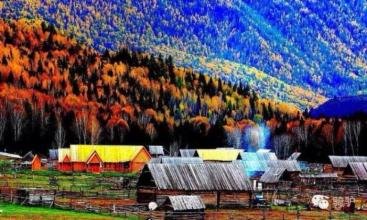
“There’s a spirit in that lake (湖圣, or Hu Shen in Chinese) and you can’t bother or upset it,” they tell him.
The Herders explained to him that 800 years ago, Genghis Khan (成吉思汗), the famous (or infamous) leader of the Mongol horde passed through that area with his massive army. He described finding an enchanting primeval forest around Kanas Lake. He was so taken with the place that he asked his guide what the name of it was. The guide said it didn’t have a name and so the great Khan named it Kanas Lake.

The name means beautiful and mysterious. The Great Khan lingered there for a few days because he liked the feng shui (风水) and wanted to be buried there when he died. One of his generals (将军) remarked that a lot of people might want to be buried there and suggested they send the Northern Sea dragon (北海 蛟龙), or something like that, I’m not really sure what kind of dragon a 蛟龙 is, to protect it.
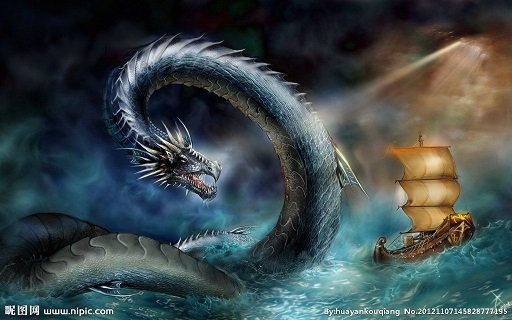
So somehow, in the way of Great Khans, they had the dragon sent to the lake and left it there with some of the Khan’s soldiers. The exact manner in which this was accomplished wasn’t related to me, but I suspect it involved one or more powerful Mongolian shamans. The soldiers eventually took wives from among the nearby tribes and became the local herdsmen. Over time, the dragon became a kind of totem, and they saw it frequently.
One local herder who knows the origins of the creature described just the dorsal fin as over 50 cm in height and over a meter long. He saw this from about 50 meters away. Then the creature dove and was out of sight.
After talking to the locals, Jin Gang believed what he saw on those two days was not some damn tree but the Kanas Lake monster.
What he wanted to know was if anyone else saw this thing. To find out, he takes a boat out on the lake and goes looking for it every day.
He gets a boat with Tong Baoming (仝保明) of the local forest service lake patrol.

Tong says he’s always creeped out by the lake. Sometimes when there’s no wind or other boats to make wakes, you can still see undulating waves making their way across the lake. He sees that pretty often and is at a loss to explain or discover their cause. After he hears Gang’s story it reminds him of a couple of incidences.
One day he’s working as usual and thinks he sees a white boat. Nothing much unusual about that except that there’s no white boats on the lake, not patrol boats anyway, which are painted a kind of burgundy or wine color. Forest ranger Sai Li Ke (赛力克) is also aboard Tong’s patrol boat and decides to record it on video.

While they’re recording the strange sight, the object separated into two objects or “split” as Sai tells it. He says the thing split while filming it. He describes this split as a duck on the water’s surface (“它是两条, 像一个鸭子一样在水面上”). His explanation is almost as incomprehensible (to me anyway) as the event itself. It means literally, I think, “It was two things, like a duck on the surface of the water.” In any case he uses two different measure words to indicate the thing he saw is some different class of creature than the duck he’s likening it to.
The men throw the boat into full throttle and race towards the object, but it’s already diving and all they can see is the tail before it submerges.
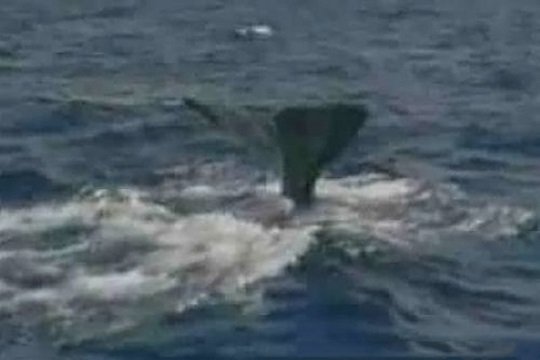
Another day out on patrol, some damn thing five stories high leaps out of the water in front of them. Amazed, astonished and scared as Hell, they high tail it out of there because being in such a small boat in the face of such a huge critter puts them danger. They get ashore only to be rocked by an earthquake.
It sounds like an incredible coincidence but as it turns out there was indeed an earthquake at that very moment reported by geologists on the Sino-Russian-Mongolian border near Kanas Lake. Did the earthquake churn up the lake and scare the creature? There were numerous witnesses to the breech as it turns out. But nobody thought to take a picture of the beast because they were all scared by the earthquake. After this event, news of the monster spread like wildfire. Most witnesses involved described what they saw as something like a plesiosaur (蛇颈龙).

Enter Yuan Guoying (袁国映), a researcher from Xinjiang institute of environmental studies (新疆环境科学研究院研究员).

He became interested in the case because of all the eyewitness reports, but disagreed with them about it being some kind of dinosaur. He says the lake is too young to have captured a dinosaur. Although it was at one time the bottom of a sea, and over time was lifted up due to geological processes, the current lake is only about 35,000 years old. Any dinosaurs were long extinct by then. If there’s a creature it must be something else.
Yuan sought help from Xiang Ligai (向礼陔), a biology professor at Xinjiang University. He’s one of the leading and most reputable biologists in Xinjiang. They go out with a team to study the lake. The team places members strategically around the lake to act as spotters, some on the lakeshore and some on the peaks and rocks above. Others prepare a vast net to cast across the full breadth of the lake. Anything and everything in the lake will be trapped by it.
The net disappears.
This was not the first scientific survey of the lake. Yuan had been to the lake before in the 1980s. In 1985 he and his students saw what appeared to be a school of 30- to 50-foot reddish brown fish swimming in the lake. If so, the largest ones could weigh up to four tons.
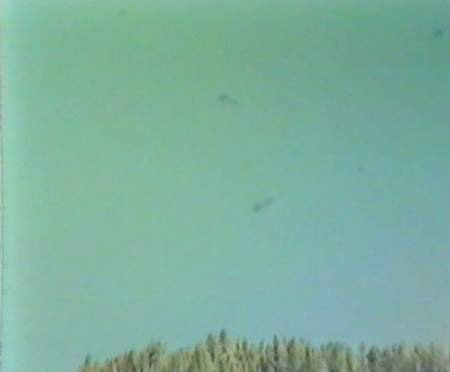
But China was a different place in 1985. It had just started on its determined course of openness and economic development and didn’t have a lot of money to spend on studying remote freshwater environments. Then in 1987, a subsequent exhibition led to the research team determining that some creature, probably some kind of fish, 10-15 feet long lived in the lake.
After three days of relentless searching, the net turns up at the downstream end of the lake in a gnarled mess. They finally manage to untangle it and find a big hole in it, a big frikkin' hole. This was a special high tech net designed specifically for this kind of mission. It was knife-proof and fire proof. Whatever had wandered into it and dragged it for all that distance before finally breaking through must be powerful and enormous. They decided to camp out and keep watch.
One day they finally spot what appears to be a huge fish churning the water. Xiang uses his binoculars to look. Other people see it too and start to shout. Xiang sees a huge Stephen Spielberg Jaws-sized, reddish shadow in the lake.
Xu Jinfa (徐金发), another professor from Xinjiang University manages to get a photograph.

According to the pic, the “fish” is the same size as the trees on the lakeshore, in other words, ginormous. The largest known freshwater fish are the Mekong giant catfish which are 3-5 m. So the question arises: What the fuck is it? Some of the team propose it is a local member of the salmon family called taimen or 大红鱼 (literally, “big red fish”) in Chinese. But over 10m long? Now there's something @fishingvideos would love to hook! But it's very hard to believe taimen this big exist even seeing them with your own eyes, talk about your fish story.

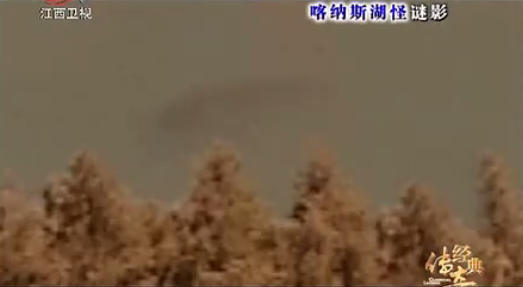
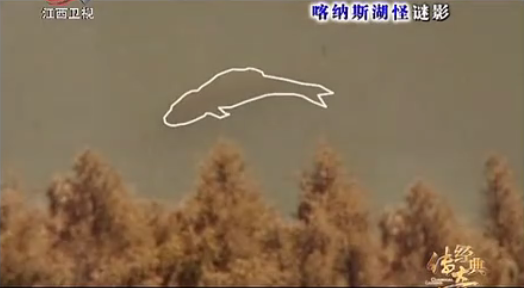
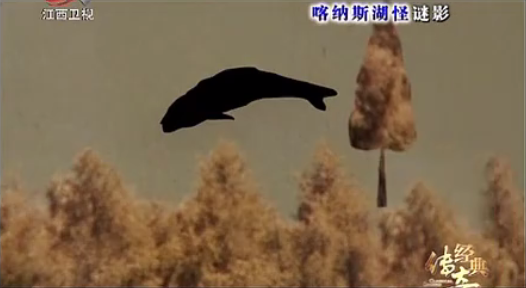
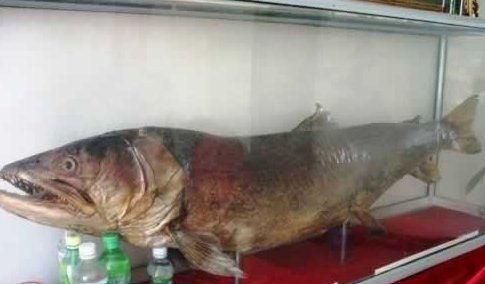
Now enter Ren Mu Lian (任慕莲) of the Heilongjang Institute of Aquaculture (黑龙江水产研究院).

He asserts that fish can’t grow much beyond their normal size. All fish, he says, have a regular growth cycle just like humans. Futhermore, members of the salmon family, called Salmonidae, have to eat a lot, and there’s not enough food for 10-meter salmon in Kanas Lake, or, as the Chinese say: “水至清则无鱼 (Water that’s too clear can’t support fish)”.
Ren launches his own expedition. He brings four big, strong nets. He and his team catch a lot of salmon over a few days, but the biggest was only 70 cm.
Did the monster know they were looking for him? Was he hiding? That usually seems to be the case when scientists go looking for these kinds of creatures.
Not long after that, Li Xiao Ling (李筱陵), a teacher at China Youth University of Political Sciences (中国青年政治学院) visits Kanas Lake.

About 200m from her boat, she sees something disturbing the water. She says it swam from close to the shore to the middle of the lake and made waves about one meter high. Lots of people on the same boat with her saw it too. It looked like a huge fish. Ms. Li managed to record the event with her hand-held video camera.
Here is a news report containing what I think is Ms. Li's footage that I managed to dig up and put up on YouTube for fellow Steemians:
After 2012, things calmed down with the Kanas Lake Monster. Although a quick search of Chinese video sharing site Youku (the YouTube of China) has a host of news reports and eyewitness videos prior to that, they suddenly drop off afterwards.
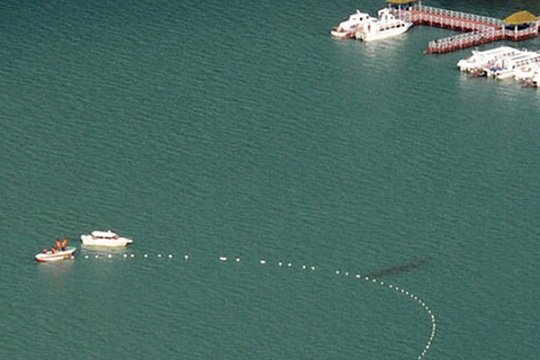
After a three-year gap, a tourist video of the Kanas Lake monster posted on May 19, 2015 is all there is. The video was posted by a user curiously calling themselves JesseCook24162083, not a Chinese name at all and not a very Chinese-looking choice for a profile pic. In fact, the ONLY videos associated with the account are three recordings of the Kanas Lake monster from May of 2015, and two of them are the same 30 second excerpt of the longer video.
That video can be seen here: http://i.youku.com/i/UMTcwNzIxMzg1Ng==
The Kanas Lake Monster, like so many of its lake monster ilk, remains a mystery. But by upvoting this post and helping it earn a lot of STEEM, you can help fund an expedition to Kanas Lake next summer by your ole pal Thorny and perhaps solve this riddle of Nature. I reckon the whole thing can be done for $2000 which would include airfare and ground transportation.
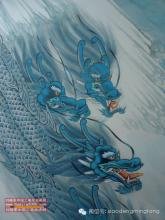
images: 1-2-3to 7-8-9&11-[10,14,15,18,20to 24,26&27-](my own screen caps of Classical Legends 2/27/2012)12-13-16-17-19-25-28-29

